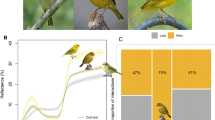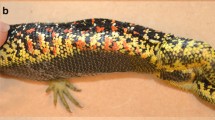Summary
During the nonbreeding season, adult Anna and black-chinned hummingbirds (Calypte anna and Archilochus alexandri) have lower defense costs and more exclusive territories than juveniles. Adult C. anna are victorious over juveniles in aggressive encounters, and tend to monopolize the most temporally predictable resources.
Juveniles are more successful than adults at stealing food from territories (the primary alternative to territoriality), presumably because juveniles are less brightly colored. Juveniles have lighter wing disc loading than adults, and consequently should have lower rates of energy expenditure during flight. Reduced flight expenditures may be more important for juveniles because their foraging strategy requires large amounts of flight time. These results support the contention of the asymmetry hypothesis that dominance can result from a contested resource being more valuable to one contestant than to the other.
Among juveniles, defence costs are also negatively correlated with age and coloration; amount of conspicucus coloration is negatively correlated with the number of bill striations, an inverse measure of age.
Similar content being viewed by others
References
Bent AC (1940) Life histories of North American cuckoos, goatsuckers, hummingbirds and their allies. Bull US Natl Mus 176:352–361
Bruce RH (1941) An experimental analysis of social factors affecting the performance of white rats. J Comp Physiol 31:395–412
Carpenter FL, MacMillen RE (1976) Energetic cost of feeding territories in an Hawaiian honeycreeper. Oecologia (Berl.) 26:213–223
Colwell RK (1974) Predictability, constancy and contingency of periodic phenomena. Ecology 55:1148–1153
Copenhaver C, Ewald PW (1980) Cost of territory establishment in hummingbirds. Oecologia (Berlin) 46:155–160
Davies NB (1978) Territorial defence in the speckled wood butterfly (Pararge aegeria). Anim Behav 26:138–147
Davies NB, Halliday TR (1978) Deep croaks and fighting assessment in toads Bufo bufo. Nature 274:683–685
Epting RJ, Casey TM (1973) Power output and wing disc loading in hovering hummingbirds. Am Nat 107:761–765
Ewald PW (to be published) Energetics of resource defense: an experimental approach. Proc 17th Int Ornithol Congr
Ewald PW, Carpenter FL (1978) Territorial responses to energy maripulations in the Anna hummingbird. Oecologia (Berlin) 31:277–292
Feinsinger P, Chaplin SB (1975) On the relation between wing disc loading and foraging strategy in hummingbirds. Am Nat 109:217–224
Feinsinger P, Colwell RK (1978) Community organization among neotropical nectar-feeding birds. Am Zool 18:779–795
Feinsinger P, Colwell RK, Terborgh J, Chaplin SB (1979) Elevation and the morphology, flight energetics, and foraging ecology of tropical hummingbirds. Am Nat 113:481–497
Hazlett BA (1966) Factors affecting the aggressive behavior of the hermit crab (Clacinus tibice) Z Tierpsychol 23:655–671
Kodric-Brown A, Brown JH (1978) Influence of economics, interspecific competition, and sexual dimorphism on territoriality of migrant rufous hummingbirds. Ecology 59:285–296
Krebs JR (1971) Territoriality and breeding density in the great tit, Parus major L. Ecology 52:2–22
Lewis DM (1972) The importance of face masks and sexual recognition and territorial behavior in yellowthroats. Jack-Pine Warbler 50:98–109
Maynard Smith J, Parker GA (1976) The logic of asymmetric contests. Anim Behav 24:159–175
Mayr F (1963) The role of ornithological research in biology. Proc 13th Int Ornithol Congr 1:27–38
Montgomerie RD (1979) Energetics of foraging and competition in some Mexican hummingbirds. PhD thesis, McGill University
Nowlis V (1941) The relation of degree of hunger to competitive interaction in chimpanzees. J Comp Psychol 32:91–115
Ortiz-Crespo FI (1972) A new method to separate immature and adult hummingbirds. Auk 89:851–857
Parker GA (1974) Assessment strategy and the evolution of fighting behaviour. J Theor Biol 47:223–243
Peek FW (1972) An experimental study on territorial function of vocal and visual display in the male red-winged blackbird, Agelaius phoeniceus. Anim Behav 20:112–128
Pitelka FA (1951) Ecologic overlap and interspecific strife in breeding populations of Anna and Allen hummingbirds. Ecology 32:641–661
Popp JL, DeVore I (1978) Aggressive competition and social cominance theory In: Hamburg DA, McCown ER (eds) Perspectives in Human evolution, vol 5: The great apes. Bejamin/Cummings, Menlo Park, pp 317–338
Siegel S (1956) Nonparametric statistics for the behavioral sciences. McGraw-Hill, New York
Smith DG (1972) The role of the epaulets in the red-winged black-bird (Agelaíus phoeniceus) social systems. Behaviour 41:251–268
Stiles FG (1973) Food supply and the annual cycle of the Anna hummingbird. Univ Calif Publ Zool 97:1–109
Stiles FG, Wolf LL (1974) Possible circannual molt rhythm in a tropical hummingbird. Am Nat 108:341–352
Watson A (1967) Population control by territorial behaviour in red grouse. Nature 215:1274–1275
Williamson FSL (1956) The molt and testis cycle of the Anna hummingbird. Condor 58:342–366
Wilson EO (1975) Sociobiology, the new synthesis. Belknap/Harvard, Cambridge
Wise LR, Zimmerman RR (1973) The effects of protein deprivation on dominance measured by shock avoidance competition and food competition. Behav Biol 9:317–329
Wolf LL (1969) Female territoriality in a tropical hummingbird. Auk 86:490–504
Wolf LL (1975) Female territoriality in the purple-throated carib. Auk 92:511–522
Author information
Authors and Affiliations
Rights and permissions
About this article
Cite this article
Ewald, P.W., Rohwer, S. Age, coloration and dominance in nonbreeding hummingbirds: A test of the asymmetry hypothesis. Behav Ecol Sociobiol 7, 273–279 (1980). https://doi.org/10.1007/BF00300667
Received:
Accepted:
Issue Date:
DOI: https://doi.org/10.1007/BF00300667




